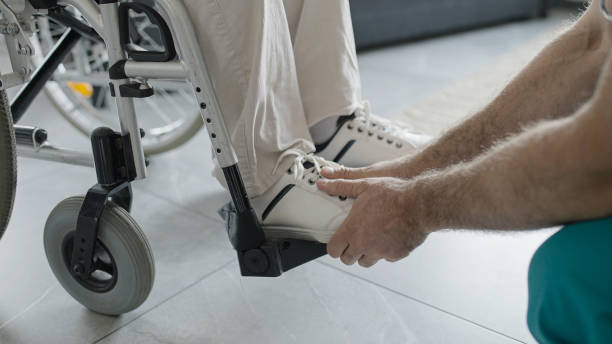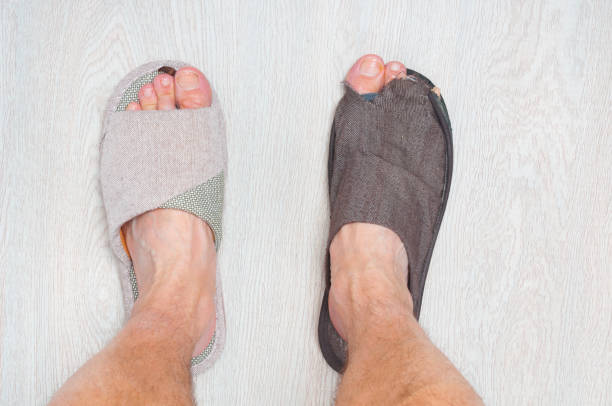Introduction

When managing Parkinson's disease, every little detail enhances the quality of life. One often overlooked aspect is the significance of comfortable and supportive footwear for patients. Parkinson's can lead to various mobility challenges, including gait disturbances and balance issues, making it crucial to prioritize the right footwear.
The following blog post will emphasize the significance of wearing comfortable and supportive footwear to alleviate symptoms and improve comfort and stability for individuals with Parkinson's disease.
How does Parkinson's disease affect the feet?
People with Parkinson's disease (PD) often experience impairments of motor and sensory functions in their feet. This can result from poor balance while walking, difficulty with coordination for small movements, changes in foot shape and size due to muscle tension or postural issues, reduced foot sensation, and weakened foot muscles. These problems can affect a person's ability to comfortably wear shoes that adequately support their feet.
The importance of comfortable and supportive footwear for Parkinson's Disease patients
As such, people with PD need to find comfortable and supportive shoes. Shoes should be lightweight, have a wide toe box for extra space, provide shock absorption to help reduce stress on the feet, and have an adjustable fit that can accommodate changes in swelling or size. Additionally, good arch support is important to maintain balance and stability during walking, while adequate cushioning helps protect sensitive areas from developing pressure sores.
People with Parkinson's may find it challenging to find suitable shoes. Hence they must allocate enough time to search for shoes that fulfill their requirements. Wearing comfortable and supportive footwear is essential to maintaining foot health to help reduce pain and improve mobility in daily activities. Additionally, custom-made orthotics may be recommended by a physician to address specific foot deformities, as well as reduce pressure on the feet.
By understanding the importance of comfortable and supportive footwear for Parkinson's patients, people can take better care of their feet and help maintain their mobility. Taking steps such as wearing appropriate shoes, using orthotics if needed, and properly fitting and selecting shoes can help ensure that feet stay healthy and comfortable.
People with Parkinson's disease should regularly check their feet for any discomfort or changes in shape or size. This can help determine if new footwear is necessary. With the right care, people with PD can keep their feet healthy and maintain their mobility.
Why is it important for Parkinson's disease patients to wear comfortable footwear?

Wearing comfortable and supportive footwear is important for Parkinson's disease patients to consider. This is because the condition can affect a person's mobility, balance, coordination, and gait, which in turn affects their ability to walk. Properly fitting shoes can be beneficial for those with Parkinson's as they provide additional support and stability while walking.
Good-fitting shoes are essential for maintaining balance, reducing pain, and supporting the feet and legs. Not only do comfortable shoes help to reduce fatigue during activities, but they also help minimize slipping or falling, which is important for anyone with Parkinson's disease who may be at higher risk of falling due to their motor impairments. Furthermore, shoes that fit properly can help reduce pressure on the feet and legs, which can help with pain relief.
In addition to providing support and stability, comfortable footwear protects the feet from injury or infection. Properly fitting shoes with good cushioning can help reduce the risk of injuries for individuals with neuropathy caused by Parkinson's disease, who may have difficulty feeling their feet. This can lower the risk of infections.
When shopping for shoes, finding a pair that fits correctly and provides arch support and shock absorption is important. Considering the material of the shoes is another crucial factor to keep in mind. Leather and canvas materials provide better airflow than synthetic materials, benefiting those with Parkinson's, as their feet may be more prone to sweating. Additionally, depending on their needs, special arch supports, or orthotics may be necessary for some individuals.
What are the benefits of wearing supportive footwear for Parkinson's disease patients?

Here are some benefits of wearing supportive footwear for Parkinson's Disease patients:
-
Improved balance and gait. Wearing shoes with extra support can help those who have Parkinson's disease maintain their balance while walking, as well as help to keep them steady during periods of tremors.
-
Reduced falls. Shoes that are designed with extra padding or support can reduce a patient's risk of falling, which is especially important for those with Parkinson's disease.
-
Reduced foot pain. Shoes that provide proper arch and cushioning support can help alleviate pain associated with walking or standing for long periods.
-
Wearing the appropriate shoes can enhance confidence and independence in individuals with Parkinson's disease, enabling them to walk with greater assurance and enjoy more autonomy.
What features should Parkinson's disease patients look for in footwear to ensure comfort and support?
When choosing footwear, it's important to consider features that may be helpful for individuals with Parkinson's.
• A secure fit and good arch support to reduce the risk of slips or trips.
• Adequate cushioning to provide shock absorption and help protect the feet from pressure points.
• Soft, flexible materials such as leather or synthetic uppers are comfortable to wear and allow the foot to move naturally.
• A wide toe box will provide space for the toes and reduce foot compression.
• Low-heeled, lightweight shoes with deep soles that are slip-resistant.
• Shoes with laces or Velcro straps can benefit those with limited dexterity or reduced motor control.
Are there any particular considerations when choosing footwear for Parkinson's disease patients with orthopedic conditions?
Yes, there are certain considerations to take into account when selecting footwear for Parkinson's disease patients with orthopedic conditions. Choosing a shoe that provides firm support and stability is important, especially in the arch area. Shoes should also have a wide base of support to help improve balance and reduce the risk of falls.
Additionally, selecting a shoe that is well-padded with shock-absorbing technology is essential, as this will help reduce the impact of sudden movements due to tremors or balance issues. Shoes should also be lightweight and provide adequate ventilation for maximum comfort. To ensure that your shoes provide the necessary support and stability, be mindful of the closure type (laces, velcro, or straps) when selecting.
How frequently should Parkinson's disease patients evaluate and replace their footwear?
It is recommended that individuals with Parkinson's disease be assessed for proper footwear every 6 to 12 months. Your doctor or physical therapist will assist you in identifying the most suitable shoe and examine any damage indications during the assessment. Shoes should be replaced when worn out or no longer provide adequate support or comfort. It is important to replace both shoes simultaneously, even if one appears in better condition.
It's important to inspect your shoes for damage periodically, even if you cannot have them assessed by a professional or buy replacements. When necessary, replace them. Signs that it is time for new shoes include decreased cushioning, stretched-out fabric or leather, and worn sole treads. Additionally, check the shoe's width and length to ensure that your feet are still well-supported.
The right footwear can be an essential part of managing Parkinson's disease. To care for your feet's health, it's crucial to routinely assess your shoes and replace them as required.
FAQ's
What helps Parkinson's patients walk?
In addition to physical therapy, exercise, and medication, wearing comfortable and supportive footwear is important in helping individuals with Parkinson's disease walk safely and securely. Properly fitted shoes that provide adequate cushioning, support, stability, and traction can help reduce the risk of falls by improving balance and coordination.
What is Parkinson's wearable technology?
Parkinson's wearable technology refers to devices worn on the body that track movement and provide feedback to help individuals with Parkinson's disease manage their symptoms. These devices use sensors, motion trackers, and algorithms to detect changes in gait, balance, and posture, allowing personalized coaching to improve mobility and reduce falls.
Does a walker help with Parkinson's?
Walkers may be helpful for some people with Parkinson's disease who have difficulty walking long distances or need extra support and stability. However, ensuring the walker fits properly and has the appropriate features, such as adjustable handles, larger wheels, and brakes, is important.
What's the best exercise for Parkinson's?
The best exercise for Parkinson's patients depends on the individual's stage of the disease and physical abilities. Exercise can help improve balance, coordination, strength, flexibility, and overall mobility. To reduce the chances of getting injured, exercises with less impact, such as walking, swimming, yoga, or tai chi, are recommended. Additionally, regular aerobic exercise can help improve energy levels and cognitive functioning. Collaborating with a doctor or physical therapist is important to create an exercise program that meets your specific needs.
Is massage helpful for Parkinson's?
Massage therapy can help reduce spasms, increase mobility, and provide relaxation benefits for people with Parkinson's disease. Massage therapists have been trained to work with individuals with movement disorders and can offer gentle yet effective techniques that can help ease stiffness, improve circulation, and reduce stress.
What calms Parkinson's?
Parkinson's disease symptoms vary between individuals. Some people have experienced reduced anxiety and better overall health and happiness by practicing relaxation techniques like breathing exercises, yoga, and meditation.
Conclusion
I hope the information provided has aided in comprehending the significance of wearing comfortable and supportive footwear for individuals with Parkinson's disease. Properly fitted shoes, appropriate exercises, physical therapy, medication, and other treatments can help improve overall mobility and reduce falls. To manage symptoms related to Parkinson's disease, it's essential to frequently assess your footwear and replace them if needed.

